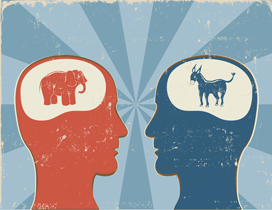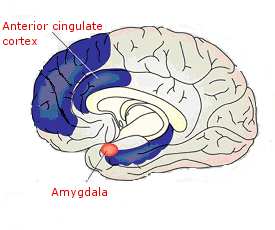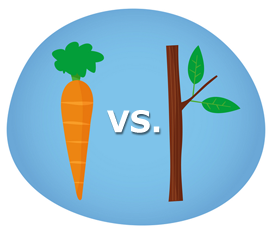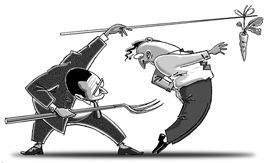The best way to lead, always, is by example.
Train a Parent, Spare a Child
Hulton Archive/Getty Images
By BRUCE FEILER
Published: January 13, 2013
SOMEONE asked me recently what my New Year's resolution was as a parent. Without thinking, I said, "more creative bribing."
I find the issue of bribing children - or to be more precise, the giving of blunt, uncreative rewards for desired behavior ("If you just stop kicking that seat in front of you on the plane, I'll give you 10 minutes of iPad time"; "Clean your room this weekend, I'll give you 10 bucks"; "If you use good manners at Grandma's house, I'll let you have an extra brownie") - to be one of the more nagging challenges of being a parent.
On one hand, I've read a small library of articles that have laid out with undeniable persuasiveness evidence that giving children tangible rewards - from money to sweets to an extra hour before bedtime - not only doesn't work in the long term, it actually has a negative effect on them. As early as the 1960s, Edward Deci, then a psychology graduate student at Carnegie Mellon, showed that when external rewards are given, subjects "lose intrinsic interest for the activity." More recently, Daniel Pink, in his best-selling book "Drive," reviewed four decades of research and concluded that offering short-term incentives to elicit behavior is unreliable, ineffective and causes "considerable long-term damage." (The main downside: People perform the task merely to get the reward; when the reward is removed, they stop doing it.)
So I got it: bribing is bad. And yet I, my wife and nearly every other parent I know resorts to this tactic with appalling regularity. As one father said to me recently when we were discussing our approaches to parenthood: "My philosophy is simple: threats and bribes."
So what's a beleaguered parent to do? I reached out to some of the harshest critics of bribing for tips on making my resolution come true.
THE TALKING CURE Dr. Deci, now a professor of psychology at the University of Rochester, said the biggest problem with tangible rewards is that they actually work, at least in the short run. "If you want somebody to do something, and if you have enough money, you can get them do it," he said. "Practically anyone, practically anything."
But with children, he pointed out, since you are trying to get them to do the behavior "more or less ongoingly for the rest of their lives," the technique will backfire unless you're prepared to offer the same reward every time. "You don't want them coming to you when they're grown," he said.
Dr. Deci recommends a three-step alternative. First, be clear about why what you're asking them do is important. Second, be interested in their point of view. "If it's something they hate doing, acknowledge that, tell them you understand it's not fun, yet the reason they need to do it is as follows," he said. Finally, communicate in a way that's not controlling. "Don't use words like 'should,' 'must' and 'have to,' " he said. "All of those things that convey to them you're a big person trying to push around a little person."
MAKE IT A GAME Alan Kazdin, the director of the Yale Parenting Center, said the problem with incentives is they focus too much attention on the desired result instead of the behavior that leads up to the result. "You can't throw rewards at behaviors that don't exist and get them," he said. "If someone says I will match your retirement fund if your perform a flamenco dance right now, my reaction is, 'Great, but it turns out I can't do that.' You have to develop the behavior very, very gradually."
For example, if you want your children to eat more vegetables, he said, instead offering them $10 to do so (a technique I once stooped to, I confess), he suggested turning the process into a game. First, take the pressure off by telling them they don't have to eat vegetables now but just keep them on their plate. "You tell them they're probably going to want to eat vegetables when they're older, because there's a nice little challenge in there," he said.
Then you offer a point to whomever can put the least amount of vegetables on their fork. The next day you have a competition for who can touch the fork to their tongue and you escalate from there. "The research is very clear," he said. "Choice is related to getting compliance in any behavior, but psychologists distinguish between real choice and the illusion of choice. Real choice doesn't make a difference; it's the feeling of choice."
SWITCH FROM IF-THEN REWARDS TO NOW-THAT Mr. Pink said the problem with bribing is not the rewards; it's the contingency, which is a form of control. "Human beings have only two reactions to control," he said. "They comply or they defy. I don't think most parents want compliant children, and I don't think they want defiant children. They want children who are active, engaged and motivated by deeper things."
He recommends replacing what he calls if-then rewards with now-that rewards, meaning the prize is giving spontaneously and after the fact. "Let's say your kid's room is a complete, utter mess, and you say, 'Fred, you really need to clean your room, or you're not going to be able to find anything,' " Mr. Pink said. "And maybe Fred does clean his room and really works hard at it. There's no harm in then saying, 'You did a great job. Let's go out for a milkshake.' "
Mr. Pink cautioned that after-the-fact rewards should be given sparingly, as they can quickly turn into an entitlement.
PRAISE IS REWARD ENOUGH If you do give rewards occasionally and unexpectedly, what type of rewards are best? Is there a preferred choice among money, treats or quality time? Carol Dweck, a professor of psychology at Stanford, said while there is no empirical research to suggest a qualitative difference, she recommends having children pick the reward rather than the adult foisting it on them. "It feels more integral to the process and gives the child a sense of ownership."
Having said that, research clearly suggests that praise is usually a sufficient reward, she said. Dr. Dweck suggests parents make their praise specific, and focus on the process the child went through to achieve the behavior, not merely the behavior itself. "You could say, 'I really liked the way you waited patiently for me to finish my phone call, because you understood that phone call was important,' " she said. "Or, 'I really liked how you expressed gratitude to Grandma, just like you appreciate it when I thank you for doing something for me.' "
I was surprised and, frankly, relieved that all the experts I spoke with said it's O.K. to resort to old-fashioned, blunt rewards on occasion. If you simply must get that child on the plane or it will take off without you, or if you absolutely need that child to stop misbehaving so you can speak to the doctor, go ahead, bribe away. As Dr. Deci told me, "If you're under a lot of stress or in a bad place, then having a conversation at that moment is not going to work."
But, he emphasized, don't let the situation end there. "You need to sit down the next afternoon when everyone's calm, talk it through from both sides, then discuss ways so the behavior doesn't happen again," he said. "Always use the blow up as a learning moment the next day."
And that, in the end, may be the biggest lesson of all. While my New Year's resolution started out as a way to get better results from my children, the real person I needed to retrain was myself.
Bruce Feiler's latest book, "The Secrets of Happy Families," will be published in February. "This Life" appears monthly.

 "We report evidence that individual-level variation in people's physiological and attentional responses to aversive and appetitive stimuli are correlated with broad political orientations. Specifically, we find that greater orientation to aversive stimuli tends to be associated with right-of-centre and greater orientation to appetitive (pleasing) stimuli with left-of-centre political inclinations."
"We report evidence that individual-level variation in people's physiological and attentional responses to aversive and appetitive stimuli are correlated with broad political orientations. Specifically, we find that greater orientation to aversive stimuli tends to be associated with right-of-centre and greater orientation to appetitive (pleasing) stimuli with left-of-centre political inclinations." "...[P]olitical conservatism is promoted when people rely on low-effort thinking. When effortful, deliberate responding is disrupted or disengaged, thought processes become quick and efficient; these conditions promote conservative ideology… low-effort thought might promote political conservatism because its concepts are easier to process, and processing fluency increases attitude endorsement.
"...[P]olitical conservatism is promoted when people rely on low-effort thinking. When effortful, deliberate responding is disrupted or disengaged, thought processes become quick and efficient; these conditions promote conservative ideology… low-effort thought might promote political conservatism because its concepts are easier to process, and processing fluency increases attitude endorsement. "
" "In a large sample of young adults, we related self-reported political attitudes to gray matter volume using structural MRI [magnetic resonance imaging]. We found that greater liberalism was associated with increased gray matter volume in the anterior cingulate cortex, whereas greater conservatism was associated with increased volume of the right amygdala...
"In a large sample of young adults, we related self-reported political attitudes to gray matter volume using structural MRI [magnetic resonance imaging]. We found that greater liberalism was associated with increased gray matter volume in the anterior cingulate cortex, whereas greater conservatism was associated with increased volume of the right amygdala... "...[R]eminders of physical purity influence specific moral judgments regarding behaviors in the sexual domain as well as broad political attitudes...
"...[R]eminders of physical purity influence specific moral judgments regarding behaviors in the sexual domain as well as broad political attitudes... "In the present study, we examine whether gaze cue effects [the ability to follow the direction of another individual’s eye movements or gaze] are moderated by political temperament, given that those on the political right tend to be more supportive of individualism—and less likely to be influenced by others—than those on the left. We find standard gaze cuing effects across all subjects, but systematic differences in these effects by political temperament. Liberals exhibit a very large gaze cuing effect while conservatives show no such effect at various SOAs [stimulus onset asynchrony]...
"In the present study, we examine whether gaze cue effects [the ability to follow the direction of another individual’s eye movements or gaze] are moderated by political temperament, given that those on the political right tend to be more supportive of individualism—and less likely to be influenced by others—than those on the left. We find standard gaze cuing effects across all subjects, but systematic differences in these effects by political temperament. Liberals exhibit a very large gaze cuing effect while conservatives show no such effect at various SOAs [stimulus onset asynchrony]... "Independent sample t-tests revealed group differences in the averaged threat interpretation scores of the 10 facial stimuli. Republican sympathizers were more likely to interpret the faces as signaling a threatening expression as compared to Democrat sympathizers. Group differences were also found for dominance perceptions, whereby Republican sympathizers were more likely to perceive the faces as expressing dominant emotions than were Democrat sympathizers...
"Independent sample t-tests revealed group differences in the averaged threat interpretation scores of the 10 facial stimuli. Republican sympathizers were more likely to interpret the faces as signaling a threatening expression as compared to Democrat sympathizers. Group differences were also found for dominance perceptions, whereby Republican sympathizers were more likely to perceive the faces as expressing dominant emotions than were Democrat sympathizers... "Our findings suggest that conservatives are sensitive to avoidance motivation [motivation through negative stimuli], which produces 'inhibition' responses manifested in greater rigidity... Based on the studies' findings, we would not expect differences between liberals and conservatives in responding to positive stimuli or incentives (i.e., approach cues), but we would expect greater inhibitory reactions by conservatives in response to negative, avoidant cues. Self-regulation appears to provide a useful perspective for understanding how one's political views may affect categorization processes and, more broadly, the association between political conservatism and rigidity."
"Our findings suggest that conservatives are sensitive to avoidance motivation [motivation through negative stimuli], which produces 'inhibition' responses manifested in greater rigidity... Based on the studies' findings, we would not expect differences between liberals and conservatives in responding to positive stimuli or incentives (i.e., approach cues), but we would expect greater inhibitory reactions by conservatives in response to negative, avoidant cues. Self-regulation appears to provide a useful perspective for understanding how one's political views may affect categorization processes and, more broadly, the association between political conservatism and rigidity." "The conservatism dimension, which corresponds to the liberal-to-conservative criterion, was associated with activity in the right DLPFC [dorsolateral prefrontal cortex]... In this study, we speculate that activity in the DLPFC may reflect a role of this region in deliberative decision-making in complex social evaluations... The observation that this region was increasingly activated by conservative beliefs could be explained by claiming that conservative statements require more complex social judgments marked by greater cognitive dissonance between self-interest and sense of fairness...
"The conservatism dimension, which corresponds to the liberal-to-conservative criterion, was associated with activity in the right DLPFC [dorsolateral prefrontal cortex]... In this study, we speculate that activity in the DLPFC may reflect a role of this region in deliberative decision-making in complex social evaluations... The observation that this region was increasingly activated by conservative beliefs could be explained by claiming that conservative statements require more complex social judgments marked by greater cognitive dissonance between self-interest and sense of fairness... "Political liberalism and conservatism differ in provide versus protect orientations, specifically providing for group members' welfare (political Left) and protecting the group from harm (political Right). These reflect the fundamental psychological distinction between approach and avoidance motivation. Conservatism is avoidance based; it is focused on preventing negative outcomes (e.g., societal losses) and seeks to regulate society via inhibition (restraints) in the interests of social order. Liberalism is approach based; it is focused on advancing positive outcomes (e.g., societal gains) and seeks to regulate society via activation (interventions) in the interests of social justice."
"Political liberalism and conservatism differ in provide versus protect orientations, specifically providing for group members' welfare (political Left) and protecting the group from harm (political Right). These reflect the fundamental psychological distinction between approach and avoidance motivation. Conservatism is avoidance based; it is focused on preventing negative outcomes (e.g., societal losses) and seeks to regulate society via inhibition (restraints) in the interests of social order. Liberalism is approach based; it is focused on advancing positive outcomes (e.g., societal gains) and seeks to regulate society via activation (interventions) in the interests of social justice." "The present research attempts to characterize how the transmission of political orientations develops over the life course... [G]enetic influences on political attitudes are absent prior to young adulthood. During childhood and adolescence, individual differences in political attitudes are accounted for by a variety of environmental influences... However, at the point of early adulthood (in the early 20s), for those who left their parental home, there is evidence of a sizeable genetic influence on political attitudes which remains stable throughout adult life."
"The present research attempts to characterize how the transmission of political orientations develops over the life course... [G]enetic influences on political attitudes are absent prior to young adulthood. During childhood and adolescence, individual differences in political attitudes are accounted for by a variety of environmental influences... However, at the point of early adulthood (in the early 20s), for those who left their parental home, there is evidence of a sizeable genetic influence on political attitudes which remains stable throughout adult life." "In this study, the relations among political ideology, exploratory behavior, and the formation of attitudes toward novel stimuli were explored. Participants played a computer game that required learning whether these stimuli produced positive or negative outcomes. Learning was dependent on participants’ decisions to sample novel stimuli... Political ideology correlated with exploration during the game, with conservatives sampling fewer targets than liberals. Moreover, more conservative individuals exhibited a stronger learning asymmetry, such that they learned negative stimuli better than positive... Relative to liberals, politically conservative individuals pursued a more avoidant strategy to the game…
"In this study, the relations among political ideology, exploratory behavior, and the formation of attitudes toward novel stimuli were explored. Participants played a computer game that required learning whether these stimuli produced positive or negative outcomes. Learning was dependent on participants’ decisions to sample novel stimuli... Political ideology correlated with exploration during the game, with conservatives sampling fewer targets than liberals. Moreover, more conservative individuals exhibited a stronger learning asymmetry, such that they learned negative stimuli better than positive... Relative to liberals, politically conservative individuals pursued a more avoidant strategy to the game… "In a group of 46 adult participants with strong political beliefs, individuals with measurably lower physical sensitivities to sudden noises and threatening visual images were more likely to support foreign aid, liberal immigration policies, pacifism, and gun control, whereas individuals displaying measurably higher physiological reactions to those same stimuli were more likely to favor defense spending, capital punishment, patriotism, and the Iraq War. Thus, the degree to which individuals are physiologically responsive to threat appears to indicate the degree to which they advocate policies that protect the existing social structure from both external (outgroup) and internal (norm-violator) threats."
"In a group of 46 adult participants with strong political beliefs, individuals with measurably lower physical sensitivities to sudden noises and threatening visual images were more likely to support foreign aid, liberal immigration policies, pacifism, and gun control, whereas individuals displaying measurably higher physiological reactions to those same stimuli were more likely to favor defense spending, capital punishment, patriotism, and the Iraq War. Thus, the degree to which individuals are physiologically responsive to threat appears to indicate the degree to which they advocate policies that protect the existing social structure from both external (outgroup) and internal (norm-violator) threats."  "We obtained consistent and converging evidence that personality differences between liberals and conservatives are robust, replicable, and behaviorally significant, especially with respect to social (vs. economic) dimensions of ideology. In general, liberals are more open-minded, creative, curious, and novelty seeking, whereas conservatives are more orderly, conventional, and better organized... A special advantage of our final two studies is that they show personality differences between liberals and conservatives not only on self-report trait measures but also on unobtrusive, nonverbal measures of interaction style and behavioral residue.”
"We obtained consistent and converging evidence that personality differences between liberals and conservatives are robust, replicable, and behaviorally significant, especially with respect to social (vs. economic) dimensions of ideology. In general, liberals are more open-minded, creative, curious, and novelty seeking, whereas conservatives are more orderly, conventional, and better organized... A special advantage of our final two studies is that they show personality differences between liberals and conservatives not only on self-report trait measures but also on unobtrusive, nonverbal measures of interaction style and behavioral residue.” "Our results are consistent with the view that political orientation, in part, reflects individual differences in the functioning of a general mechanism related to cognitive control and self-regulation. Stronger conservatism (versus liberalism) was associated with less neurocognitive sensitivity to response conflicts. At the behavioral level, conservatives were also more likely to make errors of commission. Although a liberal orientation was associated with better performance on the response-inhibition task examined here, conservatives would presumably perform better on tasks in which a more fixed response style is optimal."
"Our results are consistent with the view that political orientation, in part, reflects individual differences in the functioning of a general mechanism related to cognitive control and self-regulation. Stronger conservatism (versus liberalism) was associated with less neurocognitive sensitivity to response conflicts. At the behavioral level, conservatives were also more likely to make errors of commission. Although a liberal orientation was associated with better performance on the response-inhibition task examined here, conservatives would presumably perform better on tasks in which a more fixed response style is optimal."  "Conservatives slept somewhat more soundly, with fewer remembered dreams. Liberals were more restless in their sleep and had a more active and varied dream life. In contrast to a previous study, liberals reported a somewhat greater proportion of bad dreams and nightmares. Consistent with earlier research, the dreams of conservatives were more mundane, whereas the dreams of liberals were more bizarre...
"Conservatives slept somewhat more soundly, with fewer remembered dreams. Liberals were more restless in their sleep and had a more active and varied dream life. In contrast to a previous study, liberals reported a somewhat greater proportion of bad dreams and nightmares. Consistent with earlier research, the dreams of conservatives were more mundane, whereas the dreams of liberals were more bizarre...

